Page 405 of 514
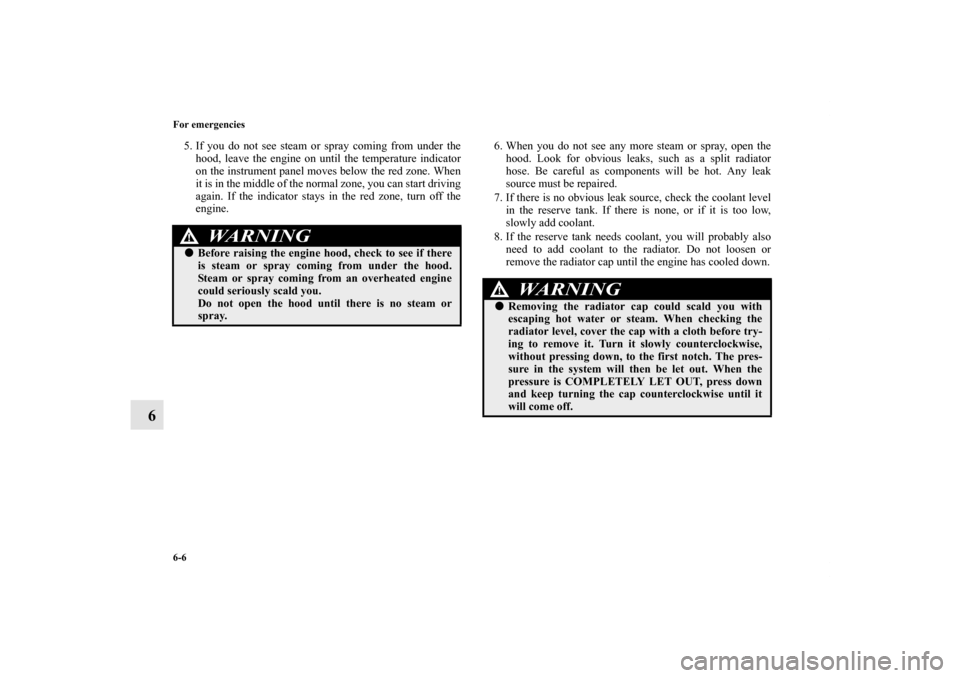
6-6 For emergencies
6
5. If you do not see steam or spray coming from under the
hood, leave the engine on until the temperature indicator
on the instrument panel moves below the red zone. When
it is in the middle of the normal zone, you can start driving
again. If the indicator stays in the red zone, turn off the
engine.6. When you do not see any more steam or spray, open the
hood. Look for obvious leaks, such as a split radiator
hose. Be careful as components will be hot. Any leak
source must be repaired.
7. If there is no obvious leak source, check the coolant level
in the reserve tank. If there is none, or if it is too low,
slowly add coolant.
8. If the reserve tank needs coolant, you will probably also
need to add coolant to the radiator. Do not loosen or
remove the radiator cap until the engine has cooled down.
WA R N I N G
!�Before raising the engine hood, check to see if there
is steam or spray coming from under the hood.
Steam or spray coming from an overheated engine
could seriously scald you.
Do not open the hood until there is no steam or
spray.
WA R N I N G
!�Removing the radiator cap could scald you with
escaping hot water or steam. When checking the
radiator level, cover the cap with a cloth before try-
ing to remove it. Turn it slowly counterclockwise,
without pressing down, to the first notch. The pres-
sure in the system will then be let out. When the
pressure is COMPLETELY LET OUT, press down
and keep turning the cap counterclockwise until it
will come off.
BK0121600US.book 6 ページ 2010年4月12日 月曜日 午前10時39分
Page 406 of 514
For emergencies
6-7
6
9. Start the engine, and slowly add coolant, up to the bottom
of the filler neck. Use plain water if you have to (and
replace it with the right coolant as soon as possible).
10. Replace the radiator cap and tighten it fully. Check the
temperature indicator. You can drive when the indicator
returns to the normal zone.
11. Have your vehicle checked by your authorized Mitsubishi
Motors dealer or a repair facility of your choice.
Tools and jack
N00836600034
StorageTools are stowed beneath the luggage floor board of the lug-
gage compartment.
The jack is stored under the floor carpet behind the rear seat.1- Jack
2- Tools (Vehicles with compact spare tire)
3- Tools (Vehicles with normal spare tire)
BK0121600US.book 7 ページ 2010年4月12日 月曜日 午前10時39分
Page 429 of 514
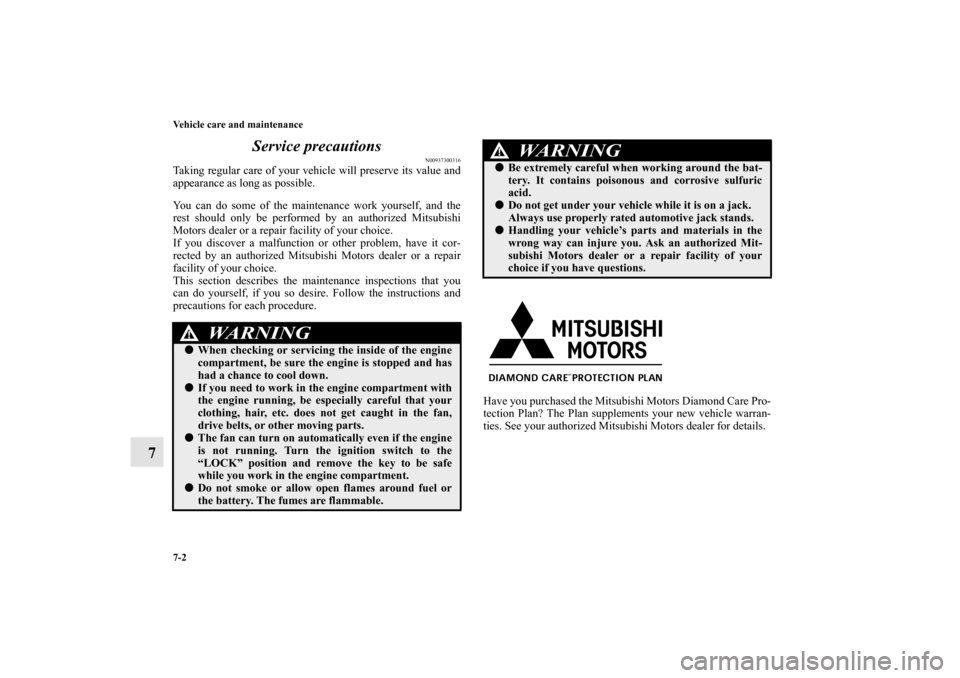
7-2 Vehicle care and maintenance
7Service precautions
N00937300316
Taking regular care of your vehicle will preserve its value and
appearance as long as possible.
You can do some of the maintenance work yourself, and the
rest should only be performed by an authorized Mitsubishi
Motors dealer or a repair facility of your choice.
If you discover a malfunction or other problem, have it cor-
rected by an authorized Mitsubishi Motors dealer or a repair
facility of your choice.
This section describes the maintenance inspections that you
can do yourself, if you so desire. Follow the instructions and
precautions for each procedure.
Have you purchased the Mitsubishi Motors Diamond Care Pro-
tection Plan? The Plan supplements your new vehicle warran-
ties. See your authorized Mitsubishi Motors dealer for details.
WA R N I N G
!�When checking or servicing the inside of the engine
compartment, be sure the engine is stopped and has
had a chance to cool down. �If you need to work in the engine compartment with
the engine running, be especially careful that your
clothing, hair, etc. does not get caught in the fan,
drive belts, or other moving parts.�The fan can turn on automatically even if the engine
is not running. Turn the ignition switch to the
“LOCK” position and remove the key to be safe
while you work in the engine compartment.�Do not smoke or allow open flames around fuel or
the battery. The fumes are flammable.
�Be extremely careful when working around the bat-
tery. It contains poisonous and corrosive sulfuric
acid. �Do not get under your vehicle while it is on a jack.
Always use properly rated automotive jack stands. �Handling your vehicle’s parts and materials in the
wrong way can injure you. Ask an authorized Mit-
subishi Motors dealer or a repair facility of your
choice if you have questions.
WA R N I N G
!
BK0121600US.book 2 ページ 2010年4月12日 月曜日 午前10時39分
Page 433 of 514
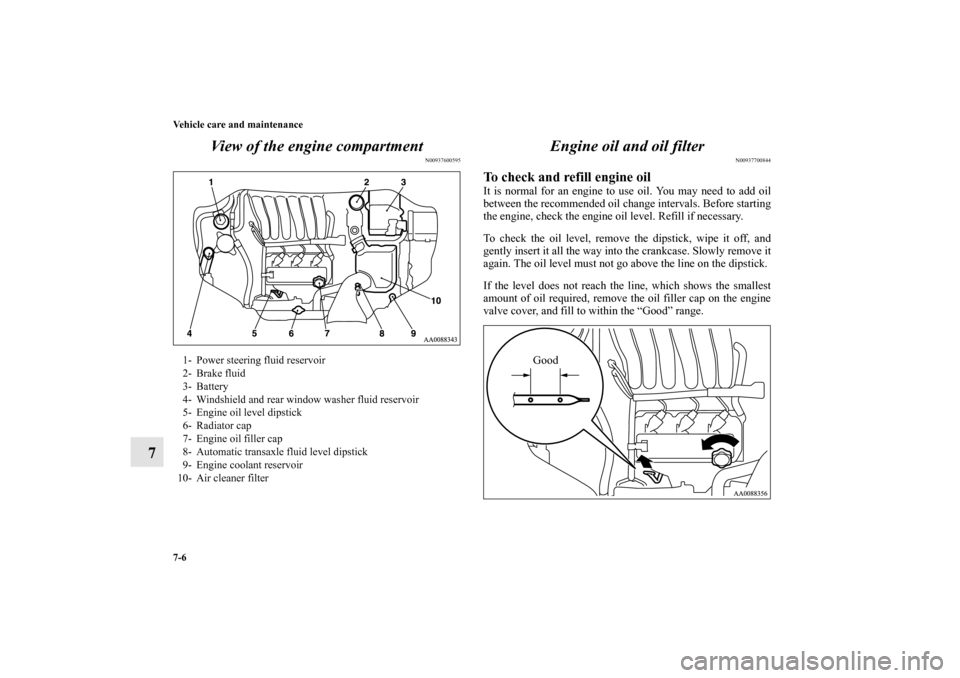
7-6 Vehicle care and maintenance
7View of the engine compartment
N00937600595
Engine oil and oil filter
N00937700844
To check and refill engine oil It is normal for an engine to use oil. You may need to add oil
between the recommended oil change intervals. Before starting
the engine, check the engine oil level. Refill if necessary.
To check the oil level, remove the dipstick, wipe it off, and
gently insert it all the way into the crankcase. Slowly remove it
again. The oil level must not go above the line on the dipstick.
If the level does not reach the line, which shows the smallest
amount of oil required, remove the oil filler cap on the engine
valve cover, and fill to within the “Good” range.
1- Power steering fluid reservoir
2- Brake fluid
3- Battery
4- Windshield and rear window washer fluid reservoir
5- Engine oil level dipstick
6- Radiator cap
7- Engine oil filler cap
8- Automatic transaxle fluid level dipstick
9- Engine coolant reservoir
10- Air cleaner filter
Good
BK0121600US.book 6 ページ 2010年4月12日 月曜日 午前10時39分
Page 436 of 514

Vehicle care and maintenance
7-9
7
To replace the oil filterThe oil filter should be replaced at the time or mileage speci-
fied in the “WARRANTY AND MAINTENANCE MAN-
UAL”.
Only use high quality replacement filters on this vehicle. The
manufacturer’s specifications for Genuine Mitsubishi oil filters
require that the filter can withstand a pressure of 256 psi
(1.8 MPa). A Genuine Mitsubishi oil filter is the best replace-
ment filter.
Follow the installation instructions printed on the filter.
Engine coolant
N00937800395
To check the coolant level The coolant reserve system provides a quick visual method for
determining the coolant level. When the engine is cold, the
level of the coolant in the reserve tank should be between the
“F” (FULL) and “L” (LOW) marks. The radiator normally
remains completely full so there is no need to remove the radi-
ator cap except for checking the coolant freeze point or replac-
ing the antifreeze coolant.
CAUTION
!�Take care not to bend the oil filter cover when
replacing the oil filter.
BK0121600US.book 9 ページ 2010年4月12日 月曜日 午前10時39分
Page 437 of 514
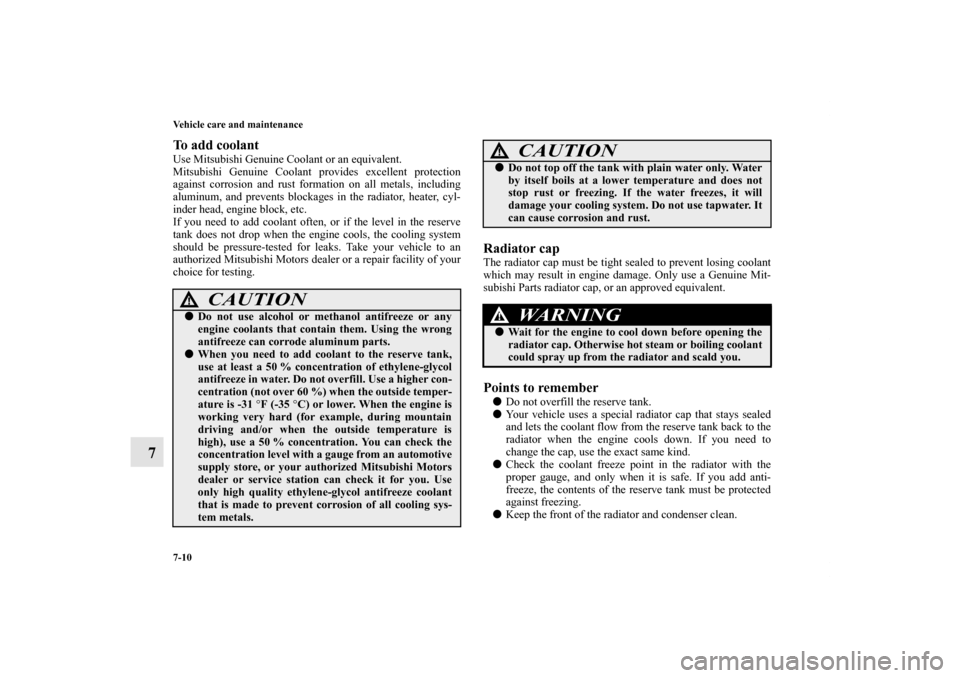
7-10 Vehicle care and maintenance
7
To add coolant Use Mitsubishi Genuine Coolant or an equivalent.
Mitsubishi Genuine Coolant provides excellent protection
against corrosion and rust formation on all metals, including
aluminum, and prevents blockages in the radiator, heater, cyl-
inder head, engine block, etc.
If you need to add coolant often, or if the level in the reserve
tank does not drop when the engine cools, the cooling system
should be pressure-tested for leaks. Take your vehicle to an
authorized Mitsubishi Motors dealer or a repair facility of your
choice for testing.
Radiator capThe radiator cap must be tight sealed to prevent losing coolant
which may result in engine damage. Only use a Genuine Mit-
subishi Parts radiator cap, or an approved equivalent.Points to remember �Do not overfill the reserve tank.
�Your vehicle uses a special radiator cap that stays sealed
and lets the coolant flow from the reserve tank back to the
radiator when the engine cools down. If you need to
change the cap, use the exact same kind.
�Check the coolant freeze point in the radiator with the
proper gauge, and only when it is safe. If you add anti-
freeze, the contents of the reserve tank must be protected
against freezing.
�Keep the front of the radiator and condenser clean.
CAUTION
!�Do not use alcohol or methanol antifreeze or any
engine coolants that contain them. Using the wrong
antifreeze can corrode aluminum parts. �When you need to add coolant to the reserve tank,
use at least a 50 % concentration of ethylene-glycol
antifreeze in water. Do not overfill. Use a higher con-
centration (not over 60 %) when the outside temper-
ature is -31 °F (-35 °C) or lower. When the engine is
working very hard (for example, during mountain
driving and/or when the outside temperature is
high), use a 50 % concentration. You can check the
concentration level with a gauge from an automotive
supply store, or your authorized Mitsubishi Motors
dealer or service station can check it for you. Use
only high quality ethylene-glycol antifreeze coolant
that is made to prevent corrosion of all cooling sys-
tem metals.
�Do not top off the tank with plain water only. Water
by itself boils at a lower temperature and does not
stop rust or freezing. If the water freezes, it will
damage your cooling system. Do not use tapwater. It
can cause corrosion and rust.
WA R N I N G
!�Wait for the engine to cool down before opening the
radiator cap. Otherwise hot steam or boiling coolant
could spray up from the radiator and scald you.
CAUTION
!
BK0121600US.book 10 ページ 2010年4月12日 月曜日 午前10時39分
Page 438 of 514
Vehicle care and maintenance
7-11
7
�If the temperature of the engine coolant does not rise after
the engine is warmed-up, take your vehicle to an autho-
rized Mitsubishi Motors dealer or a repair facility of your
choice to have the thermostat checked, and replaced if
necessary.
Air cleaner filter
N00937900295
The air cleaner filter will get dirty and dusty from use and not
filter properly. Replace it with a new filter using the schedule
in the “WARRANTY AND MAINTENANCE MANUAL”.
Unclamp and take out the air cleaner filter.
After replacing the air cleaner filter, put the cover back on in its
original position. NOTE�Genuine Mitsubishi Parts are recommended when replac-
ing the air cleaner filter.
CAUTION
!�Take care not to scratch the engine air flow sensor
when removing the air cleaner cover.
BK0121600US.book 11 ページ 2010年4月12日 月曜日 午前10時39分
Page 439 of 514
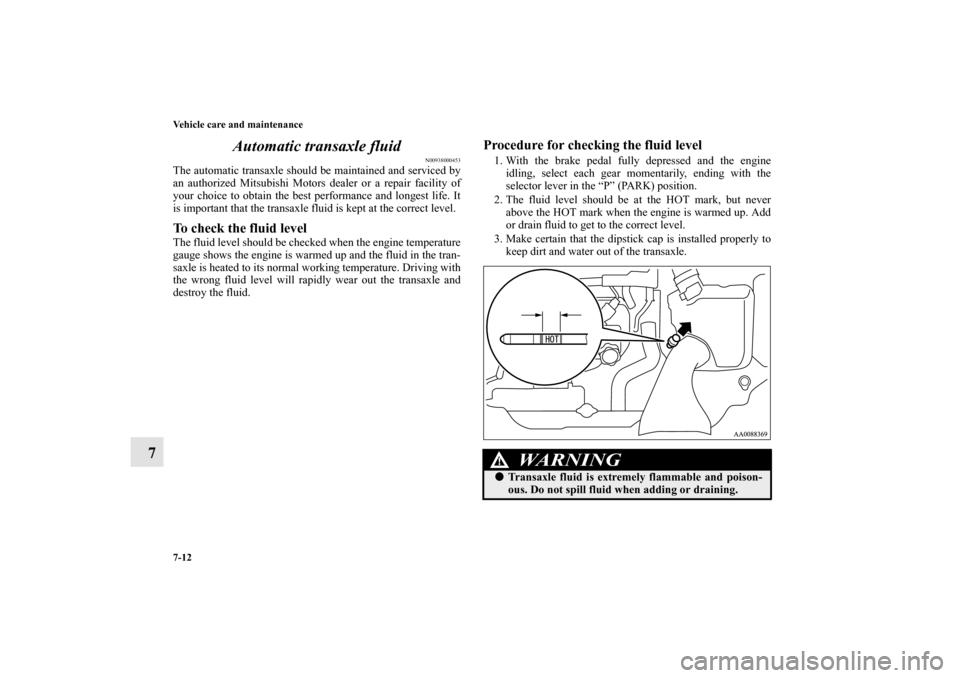
7-12 Vehicle care and maintenance
7Automatic transaxle fluid
N00938000453
The automatic transaxle should be maintained and serviced by
an authorized Mitsubishi Motors dealer or a repair facility of
your choice to obtain the best performance and longest life. It
is important that the transaxle fluid is kept at the correct level. To check the fluid level The fluid level should be checked when the engine temperature
gauge shows the engine is warmed up and the fluid in the tran-
saxle is heated to its normal working temperature. Driving with
the wrong fluid level will rapidly wear out the transaxle and
destroy the fluid.
Procedure for checking the fluid level 1. With the brake pedal fully depressed and the engine
idling, select each gear momentarily, ending with the
selector lever in the “P” (PARK) position.
2. The fluid level should be at the HOT mark, but never
above the HOT mark when the engine is warmed up. Add
or drain fluid to get to the correct level.
3. Make certain that the dipstick cap is installed properly to
keep dirt and water out of the transaxle.
WA R N I N G
!�Transaxle fluid is extremely flammable and poison-
ous. Do not spill fluid when adding or draining.
BK0121600US.book 12 ページ 2010年4月12日 月曜日 午前10時39分